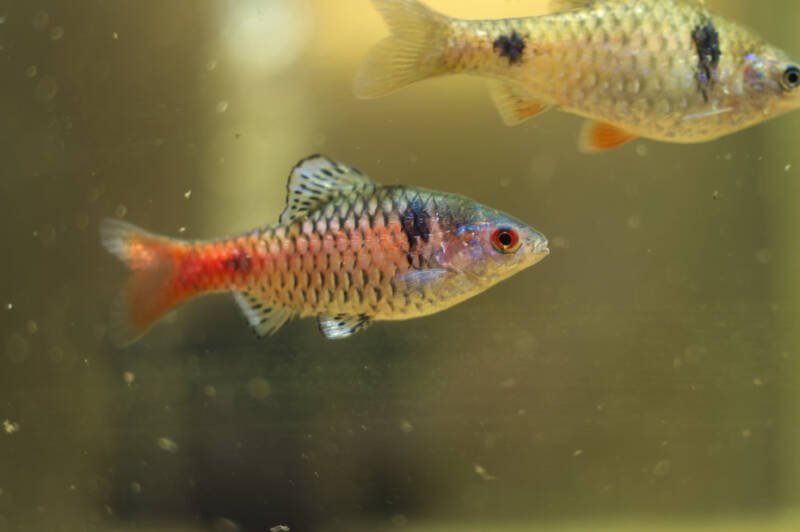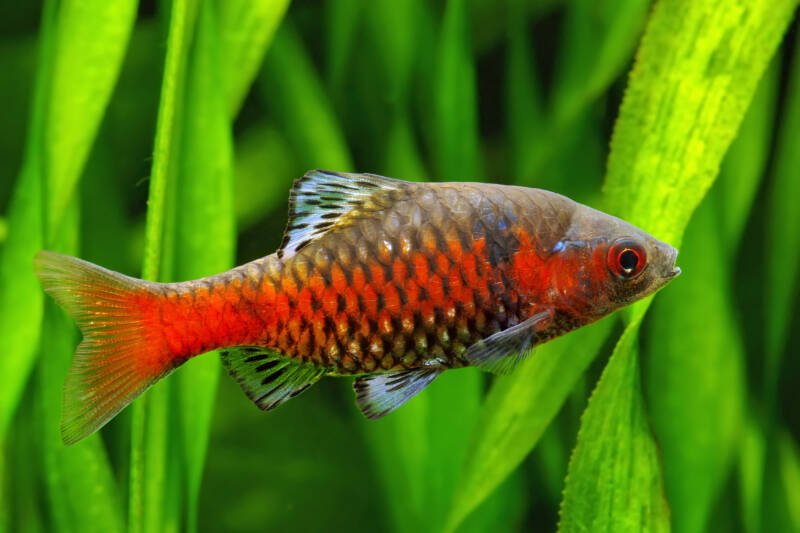Have you seen the Odessa barb, also known as the scarlet barb?
This freshwater fish boasts a stunning appearance, with males sporting a bright red stripe that seems to radiate from within, crossing under a black mesh of scales.

Aside from its captivating appearance, the Odessa barb is also an easy-to-care-for and peaceful fish. Its accommodating nature makes it an excellent addition to any beginner’s thriving community tank.
Don’t miss the chance to add the Odessa barb (Pethia padamya) to your aquarium and enjoy the beauty and serenity it brings.
At a Glance
| Tank Size: | 30 gallons (for 5 barbs) |
| Group Size: | 5 (recommended) |
| Water Temperature: | 70 to 79°F (21 to 26°C) |
| pH: | 6 to 7 |
| Hardness: | 4 to 10 KH |
| Lifespan: | 3 to 5 years |
| Breeding: | Egg scatterer |
| Adult Size: | 3 inches (7,6 cm) |
| Usual Place in the Tank: | Allover (mostly middle region) |
In this article
Natural Habitat
The Odessa barb originates from freshwater ponds and rivers in Southeast Asia, particularly in central Myanmar.
These waters are slightly acidic, with plentiful vegetation and a moderate current.
Appearance and Biology

There is no doubt – the Odessa barb has a striking look! The males sport the most brilliant colors, while the females’ coloration is more subdued.
Both sexes have a black, mesh-like pattern to their scales. The fish have sturdy, angled fins and a forked tail.
Males are silver-colored in the body, with a thick, bright red line extending from behind the eye all the way to the tail fin.
This line is punctuated with two vertical, black spots: one behind the gills and the other at the base of the tail. Black streaks along the rays accent their fins.
Females are silver in color, with a slight pink or golden hue. They lack the brilliant red line that the males have but share similar black spots on their bodies and fins.
Females also tend to be larger than males, especially when they are carrying eggs.
Size
You can expect your fully-grown Odessa barb to reach a length of about three inches (7.6 cm). Again, the males may be slightly smaller than the females.
Lifespan
The lifespan range for Odessa barb is three to five years. As always, proper care impacts the lifespan of your fish.
Behavior
Here’s where things get fun! The Odessa barb is not only beautiful to look at; they are also very active and fun to watch!
They are shoaling fish, which means they like to stick together in the tank most of the time.
But they also love to explore, and you will find them checking out all the levels and objects in your tank.
Not only are they wonderfully active, but they are also relatively peaceful.
Every now and then, you may see some aggression among male barbs seeking to establish dominance. These interactions are usually short-lived.
If the aggression persists, you may have to remove the weaker fish. They tolerate other species but may nip at the fins of slower moving fish.
Keep your Odessa barbs in a group of at least five. This may minimize any aggressive behaviors as it increases their comfort level.
How many per gallon?

A 10-gallon tank is sufficient for a single fish. As we have said, Odessa barbs do better in a group of at least five, so for this setup, plan on a minimum tank size of 30-gallons.
Because this fish is very active and loves to swim, an even larger tank would be better.
Tank setup
Decorations
In consideration of their natural habitat, Odessa barbs do best in well-planted tanks.

Some suggestions for live plants are hornwort or water wisteria, but you can try any type that suits you.
Arrange the plants so that your fish have plenty of swimming room to accommodate their high activity levels.
Because the fish explore all tank levels, include rocks or driftwood on the tank bottom for them to enjoy.
Water Conditions
Odessa barbs can tolerate a range of water parameters, but keep the conditions are consistent to ensure your fish’s health.
They prefer slightly acidic water, at a pH level of 6 to 7. Water hardness should be moderate and in the range of 4 to 10 KH.
Keep the water temperature between 70 to 79 degrees Fahrenheit (21 to 26 degrees C) and test your water regularly.
Equipment
Install a filter with moderate to high filtration to allow for sufficient water movement.
These fish prefer lower lighting, so either use a lower power tank light or consider adding floating plants to diffuse the light.
Tank Mates
You can introduce your Odessa barbs into a community tank with a variety of other fish, and they will get along just fine.
Consider the following to pair with your Odessa barb:
Avoid the following:
- Freshwater snails
- Slower moving fish with long fins, such as angelfish
- Larger, more aggressive fish.
Food and Diet
Odessa barbs are omnivores. While they can thrive on quality commercial flake foods, they will be healthiest with a varied diet that includes freeze-dried and live foods.
Supplement your fish’s diet with the following nutrient-rich foods:
- Brine shrimp
- Bloodworms
- Daphnia
- Vegetables (cucumbers, lettuce).
Feed your fish twice per day and only as much as they can finish in a few minutes.
Breeding
Odessa barbs are an egg scattering species. As such, breeding in a community tank may not be successful.
Setting up a separate tank may increase your odds of success.
Tank Setup
While some recommend setting up a bare bottom tank, others suggest keeping the tank well planted.
A two-to-one ratio of females to males may further your chances of breeding.
Breeding Behavior
Mating pairs will form. Slightly lower the pH of the water to encourage egg dropping and fertilization.
The females will then scatter the eggs while the male fertilizes them. Once this is done, remove the adults from the tank. The eggs should hatch in three to five days.
Caring for the Fry
Change part of the water daily while the fry are growing. Feed the fry infusoria for the first few weeks.
After that, they should be grown enough to accept larger foods like baby brine shrimp.
Hardiness
This species is hardy and is not prone to any unique diseases. As freshwater fish, they are susceptible to typical tank diseases.
Ich, which presents as white spots, is a common one. Correct any necessary tank conditions and add appropriate medication to the water.
It is important to recognize common freshwater ailments and treat them quickly. Ich can eventually kill your fish if not treated.
Frequently Asked Questions
Are Odessa barbs aggressive?
Typically, no. Odessa barbs are notable for their peaceful nature. Occasional scuffles for dominance can break out among male Odessas.
Are Odessa barbs fin nippers?
They can tend to nip at slower-moving fish with long fins. Keeping Odessa barbs in a group of at least five can lessen the chances of this happening.
How do you breed Odessa barbs?
At a quick glance, breeding Odessa barbs is simple. Male and female are visually easy to distinguish.
Prepare a separate breeding tank and remove the adults after egg spawning and fertilization are complete.
Final Recommendations
The Odessa barb is an excellent fish for someone new to tank keeping.
They are peaceful, easy to care for, tolerant of a range of tank conditions, and not particularly prone to disease.
Expect to pay between $4 to $7 per fish for an Odessa barb. Remember that it is best to purchase a group of at least five to allow them to shoal.
Have you introduced a group of Odessa barbs to your community tank?
Which aquatic plants do your barbs like best?